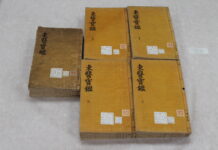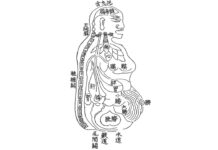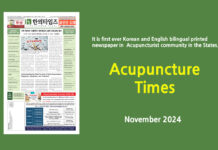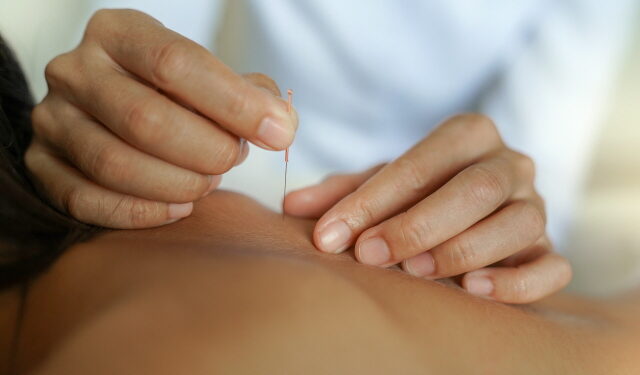Written by Jeonghwa Lee, Choonjae Lee, Published by Korea Institute of Oriental Medicine
The meridians and collaterals are pathways connecting one acupuncture point to another for the circulation of qi and blood in the biological response ystem. The meridians are correlated with the five viscera and six bowels internally, and with the skin externally. They are pathological response pathways along which energy, yang qi, and blood circulate. Meridian theory studies the meridian system’s physiological functions and pathological changes, and also investigates the meridians’ relationship with the yin and yang organs.
The Meridian is the English translation of the Korean word Gyeong-rak.
Gyeong
-means roads
-repensents the bigger pathways in the meridian system and major highways vertically circulating across the human body;
-is also called a meridian vessel, and circulates through deep parts of the body.
Rak
-means complicated networks and webs;
-represents the smaller pathways in the meridian system and reaches every single part of the body through web-like channels;
-is also called a collateral vessel, and circulates through the shallow parts of the body.
Meridians are response pathways for qi and blood in the human body.
All the human parts mentioned here, such as five viscera and six bowels, eyes, nose, mouth and ears, skin and hair, and muscles and bones are closely connected with one another through these pathways. In the mountains, we see valleys; and in the valleys, we find streams. The meridians can be compared with the streams in the valleys since they flow between or sometimes in and out of human parts. At some places of the meridians, energy is concentrated. These locations are called acupuncture points (which are the usual focus of acupuncture treatments).
The meridians include twelve standard meridians, eight extra meridians6, fifteen collateral vessels7, twelve meridian divergences8, twelve meridian sinews9, and tertiary collateral vessel10.
Overview of twelve standard meridians is given as follows:
Main channels of the overall meridian system
- Twelve standard meridians correspond to the five viscera and six bowels, and the pericardium (a total of 12 organs).
- They flow in three parts: the head, the trunk, and the limbs
- They are grouped into the hand meridians, foot meridians, yang meridians (which belong to the bowels and flow along the lateral parts of the limbs), and yin meridians (which belong to the viscera and flow along the medial aspects of the limbs).
The twelve standard meridians, composed of a total of 12 main channels, govern the circulation of qi and blood in the human body. These main channels include the greater yin lung meridian of hand (lung meridian, in short), yang brightness large intestine meridian of hand (large intestine meridian, in short), yang brightness stomach meridian of foot (stomach meridian, in short), greater yin spleen meridian of foot (spleen meridian), lesser yin heart meridian of hand (heart meridian, in short), greater yang small intestine meridian of hand (small intestine meridian, in short), greater yang bladder meridian of foot (bladder meridian, in short), lesser yin kidney meridian of foot (kidney meridian, in short), reverting yin pericardium meridian of hand (pericardium meridian, in short), lesser yang triple energizer meridian of hand (triple energizer meridian, in short), lesser yang gallbladder meridian of foot (gallbladder meridian, in short), and reverting yin liver meridian of foot (liver meridian, in short).
Among these 12 meridians, the lung meridian, pericardium meridian, and heart meridian are called the three yin meridians of hand, which flow from chest to arm, leading to the yang meridians of foot. The large intestine meridian, triple energizer meridian, and small intestine meridian are called the three yang meridians of the hand, which flow from arm to head, leading to the yang meridians of the leg. The stomach meridian, gall bladder meridian, and urinary bladder meridian are called the yang meridians of the foot, which flow from head to leg, leading to the yin meridians of the leg. The spleen meridian, liver meridian, kidney meridian are called the yin meridians of the foot, which flow from leg to abdomen, leading to the yin meridians of the arm.
The twelve standard meridians circulate in the following order:
The lung meridian the large intestine meridian the stomach meridian the spleen meridian the heart meridian the small intestine meridian the urinary bladder meridian the kidney meridian the pericardium meridian the triple energizer meridian the gall bladder meridian the liver meridian The followings are the flow and the function of each meridian.
1. Lung Meridian
The lung meridian, which has 11 acupuncture points, originates in the region just above the umbilicus, passes below the clavicle, and travels along the medial side of the tip of the thumb. This meridian is usually used to treat respiratory diseases and diseases in the larynx, chest or lungs. It also treats diseases such as cough and pain in the chest, shoulders and arms.
2. Large Intestine Meridian
The large intestine meridian, which has 20 acupuncture points, originates on the tip of the index finger, passes through the intersection of the first and second metacarpal bones, ascends along the radial side of the thumb, passes over the shoulder, and crosses above the clavicle. It then travels downwards to the large intestine while the branch channel travels upwards to the neck, passes around the mouth, and ends at the side of the nose. This meridian treats abdominal diseases, neuropsychiatric diseases, fever, diseases in the eyes, mouth, teeth, nose and throat, abdominal pain, borborygmus, diarrhea, constipation, dysentery, and pain in the hands and arms.
3. Stomach Meridian
The stomach meridian, which has 45 acupuncture points, starts from the side of the nose, flows to the corner of the mouth, and runs to the angular part of the mandible. It then flows downward to the nipple, travels along the anterior side of the thigh, and reaches the patella. It continues further down along the anterior border of the lateral aspect of the tibia to the deep acupuncture point in the ankle, and reaches the tip of the second toe. There are several branch channels, one of which travels to the mandible, ascending in front of the ear, following the anterior hairline, and ending at the forehead.
In the chest, the meridian descends straight along the sternum and reaches the stomach. This meridian mainly deals with diseases in the digestive, neuropsychiatric, respiratory, and circulatory systems. It also treats gastric pain, vomiting, borborygmus, abdominal dropsy, Bell’s palsy (deviated eye and mouth), and epistaxis.
Gastric diseases send various signs to the meridian. For example, a problem in the stomach results in various symptoms such as enormous pain in the sternum, chronic pain on both sides of the forehead, red rough (pimple-like) spots around the mouth. Acute gastroenteritis can send spasms to the yang brightness meridian, causing convulsions in the limbs.
4. Spleen Meridian
The spleen meridian, which has 21 acupuncture points, originates in the medial aspect of the tip of the big toe, ascends to the depression near the medial malleolus up to the medial aspect of the leg, and reaches the intersection with the stomach meridian. It then curves lateral to the midline to the intercostals, space up to the second intercostals space, and leads to the heart meridian.
Brach channels are located in the jaw. This meridian mainly governs diseases in the digestive and urinogenital systems, gastric pain, belching, vomiting, jaundice, dropsy, lethargy, and lower extremity pain.
5. Heart Meridian
The heart meridian, which has 9 acupuncture points, starts from the umbilicus, travels upward along the sternum, and runs across the chest to the axilla, where it meets the spleen meridian. Then it flows along the medial aspect of the arm, ending at the tip of the little finger.
Branch channels ascends to the face. Places where facial muscles move when laughing, places of frequent pimple development, usual pockmark areas, places where rouge is applied, and blushing areas of a consumptive patient are all identical, since they are the places indicative of the conditions of the heart.
This meridian usually treats chest pains, diseases in the circulatory and neuropsychiatric systems, heartaches, palpitations, sleeplessness, and pain in the sides.
6. Small Intestine Meridian
The small intestine meridian, which has 19 acupuncture points, originates from the ulnar aspect of the tip of the little finger, travels all the way to the shoulder, and intersects the urinary bladder meridian near the vertebrae. Then it flows up to the face along the lateral aspect of the neck, ending anterior to the tragus of the ear. Passing the shoulder, one of the branch channels ascends to the face, while the other flows towards the abdomen. This meridian mainly governs the small intestine in the abdomen, chest, heart, throat ailments, fever, nervous diseases, and treats deafness, bloodshot eyes, and throat pain.
7. Bladder Meridian
The bladder meridian, which has 67 acupuncture points, is connected with the small intestine meridian and originates from the inner canthus of the eye. Passing through the forehead, it flows up to the vertex, where it bifurcates into two lines. One line reaches the temple and the other enters the brain. The latter runs along the posterior aspect of the neck, and branches again into two lines descending along the back and the side. One descends next to the tailbone, and the other passes through the gluteal region. The two meet at the popliteal fossa, descending along the posterior aspect of the gastrocnemius
muscle and further to the posterior inferior aspect of the lateral malleolus, and ending at the lateral posterior side of the tip of the little toe. This meridian governs diseases in the urinogenital and respiratory systems, and treats dysuria, enuresis, dysentery, eye pain, stuffy nose, and lumbago.
8. Kidney Meridian
The kidney meridian, which has 27 acupuncture points, begins beneath the little toe, runs along the middle of the sole, travels behind the medial malleolus and encircles the malleolus. Ascending along the medial side of the leg, it travels to the superior border of the symphysis pubis and runs up to the clavicle. This meridian mainly governs diseases in the urinogenital and respiratory, and digestive systems, and treats tinnitus, lumbago, and irregular menstruation.
9. Pericardium Meridian
The pericardium meridian, which has 9 acupuncture points, originates in the chest where it is connected to the kidney meridian. It passes through the anterior side of the shoulder and travels along the medial aspect of the arm. Entering the palm, it reaches the tip of the middle finger. This meridian governs the chest, heart, and diseases in the circulatory and neuropsychiatric systems, and treats heartaches, palpitations, suffocating sensations in the chest, weakened hearts, palpitations, and mental diseases.
10. Triple Energizer Meridian
The triple energizer meridian, which has 23 acupuncture points, starts from the ulnar aspect of the tip of the ring finger, runs along the lateral aspect of the upper arm, and reaches the shoulder region. It then runs along the posterior border of the ear, ending at the lateral end of the eyebrow. The branch channel crosses over the shoulder and flows down to the chest.
This meridian governs cardiopulmonary diseases and diseases in throat, eyes and ears. It also treats tinnitus, deafness, throat pain, and bloodshot eyes.
11. Gallbladder Meridian
The gall bladder meridian, which has 40 acupunctures points, originates from the outer canthus of the eye and ascends to the corner of the forehead. Traveling along the lateral side of the head and the posterior aspect to the ear, it runs down to the highest point of the shoulders. From there it further descends to the axilla, enters the chest, descending along the side. It then follows the anterior aspect of the lateral malleolus, ending at the lateral side of the fourth toe’s tip. This meridian governs the chest and rib sides, liver and gall bladder diseases, temporal regions, and otitis. It also treats the bitter taste in the mouth, vomiting, vertigo, migraine, and eye pain.
12. Liver Meridian
The liver meridian, which has 14 acupuncture points, begins from the lateral side of the big toe, travels upward to the anterior aspect of the medial malleolus, and ascends along the medial side of the leg. It curves in the abdomen and chest, and then runs up to the head, ending at the tissue surrounding the eye. This meridian deals with the urinogenital organs, and liver and gall bladder diseases. It treats eye pain, lumbago, nausea, and dysuria.
- titleThe meridians and collaterals are also called channels and networks; meridians; or channels, in short.
- 6Eight extra meridians refer to governor vessel, conception vessel, thoroughfare vessel, belt vessel, yin
heel vessel, yang heel vessel, yin link vessel, and yang link vessel. - 7Fifteen collateral vessels refer to the main collaterals derived from the fourteen meridians and together
with the great collateral of the spleen, fifteen in all. - 8Twelve meridian divergences refer to the divergent passages of the twelve main meridians going
deep in the body. - 9 Twelve meridian sinews refer to the sinew systems attributed to the twelve meridians.
- 10Tertiary collateral vessel refers to small branches of the collateral/network. It is also called grandchild
collateral vessel.
































